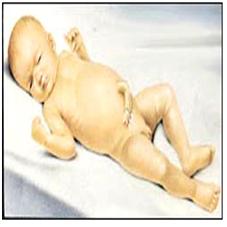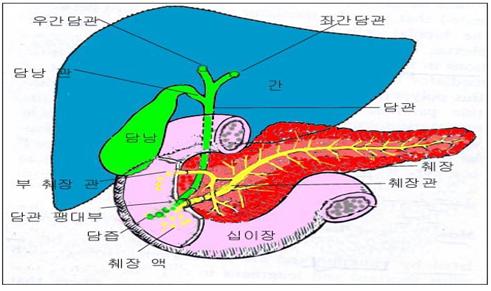신생아 황달(신생아 빌리루빈 과잉혈/신생아 빌리루빈 과잉혈증/신생아 과빌리루빈 혈증/신생아 고빌리루빈 혈증), Neonatal jaundice(Neonatal hyperbilirubinemia)

그림 117.심한 신생아 황달
출처: Ross Laboratories, Columbus, Ohio 43216, Division of Laboratories, USA와 소아가정간호백과
- 신생아에게 생기는 황달을 통틀어 신생아 황달이라 하고 신생아 빌리루빈 과잉혈, 신생아 빌리루빈 과잉혈증, 신생아 고빌리루빈 혈증 또는 신생아 과빌리루빈 혈증이라고도 한다.
- 빌리루빈의 혈중 농도가 정상 이상으로 증가되어 피부와 눈 흰자위 등이 노랗게 될 수 있다.
- 황달은 어떤 병의 증상 징후이지 병명은 아니다.
- 정상 신생아들의 60%가 생후 7일 이내 황달에 걸린다.
- 혈액 내 적혈구에서 나온 빌리루빈은 간에서 UGTIAI 효소에 의해 빌리루빈 글루쿠론니드로 대사 된다.
- 빌리루빈은 담즙 성분의 일종이다.
- 혈액 내 적혈구에서 나온 빌리베리딘(Biliverdin)은 간에서 빌리루빈(Bilirubin)으로 전환된다. 빌리베리딘(Biliverdin)과 빌리루빈(Bilirubin)은 그때그때 적절히 담즙의 성분이 된다.
- 빌리루빈은 간접 빌리루빈(비포화 빌리루빈/간접형 빌리루빈/Unconjugate bilirubin/Indirect bilirubin)과 직접 빌리루빈(포화 빌리루빈/직접형 빌리루빈/Conjugate bilirubin/Direct bilirubin)이 있다. 빌리루빈은 담집의 성분이 되고 그 담집은 담관 속을 통해 십이지장관 속으로 분비된다.
- 생리적으로 또는 병적으로 혈중 간접형 빌리루빈(Unconjugate bilirubin)을 정상 농도 이상이 되면 고 빌리루빈혈증이 생기고 눈의 공막이 노랗고 피부가 노랗고 신생아 황달이 생긴다.
- 미국 만삭 신생아들과 거의 만삭에 가깝게 출생한 미숙아들의 1,000명 중 5~40명이 빌리루빈 광선요법으로 치료를 받는다(출처; NEJM Febuary 2008 p.920).
- 신생아 황달의 원인, 증상 징후, 치료, 예후 등이 신생아기 이후의 영유아들이나 학령기 아이들이나 성인들에게 생기는 황달의 원인, 증상 징후, 치료, 예후기와 다른 점이 많다.
| 신생아 황달과 신생아기 이후 황달의 분류 |
- 모유와 신생아 황달
- 용혈성 빈혈
- 미숙 신생아 황달
- 생리적 신생아 황달
- Rh 부적합으로 인한 신생아 황달
- ABO 혈액형 부적합으로 인한 신생아 황달
- 모유를 먹는 신생아에게 생기는 신생아 황달
- 간염으로 인한 신생아 황달
- 선천성 담관 폐쇄로 생기는 신생아 황달
- G-6-인산 포도당 탈수소효소 결핍(G-6-P-D 결핍)으로 인한 신생아 황달
- 다른 원인으로 인한 신생아 황달
표 2. 신생아 과빌리루빈 혈증
| 빌리루빈 생성이 증가될 때 | 빌리루빈 분비가 감소될 때 | 빌리루빈 생성이 증가되고 빌리루빈 분비가 감소될 때 |
| ABO 혈액형 부적합으로 생기는 신생아 황달 Rh 부적합으로 인한 신생아 황달 소 혈액형 부적합으로 생기는 신생아 황달 G-6-인산 포도당 탈수소효소 결핍(G-6-PD deficiency)으로 인한 신생아 황달 타박상 뇌실 출혈 적혈구 증가증 임산부 당뇨병 유전성 구상 적혈구증 |
생리적 신생아 황달 모유수유 황달 장관폐쇄 임신부 간질환 유전성 빌리루빈 분비장애 크리글러 나잘 증후군(크리글러-나자르증후군) Crigler-Najjar syndrome, 1형과 2형 루시 드리시클 증후군(Lucey Driscoll syndrome) |
미숙아 패혈증 |

그림 118.간, 췌장과 담즙 분비관, 십이지장관
Copyright ⓒ 2011 John Sangwon Lee, MD., FAAP
| Update, 5/5/2021, Pediatrics
Bilirubin screen before newborn discharge is performed to identify neonate risk for future hyperbilirubinemia. the use of TSB plus models is an excellent ability to predict post-discharge TSB above the phototherapy threshold. 업데이트, 2021년 5월 5일, 신생아 퇴원 전 빌리루빈 선별 검사를 통해 신생아의 향후 고빌리루빈혈증 위험을 확인할수 있다. TSB plus 모델의 사용은 광선 요법 임계값 이상으로 퇴원 후 TSB를 예측하는 탁월한 능력이 있고 한다. |
Neonatal jaundice (Neonatal hyperbilirubinemia) 신생아 황달(신생아 빌리루빈 과잉혈/신생아 빌리루빈 과잉혈증/신생아 과빌리루빈 혈증/신생아 고빌리루빈 혈증)

Figure 117. Severe neonatal jaundice. Source: Ross Laboratories, Columbus, Ohio 43216, Division of Laboratories, USA and Pediatric Home Nursing Encyclopedia.
- Jaundice in newborns is called neonatal jaundice, and it is also called neonatal bilirubin hyperemia, neonatal hyperbilirubinemia.
- Bilirubin’s blood levels may increase above normal, causing yellow skin and whites of the eyes.
- Jaundice is a symptom of a disease, not a disease name. 60% of normal newborns develop jaundice within 7 days of life.
- Bilirubin from red blood cells in the blood is metabolized to bilirubin glucuronide by the enzyme UGTIAI in the liver.
- Bilirubin is a type of bile component. Biliverdin from red blood cells in the blood is converted into bilirubin in the liver.
- Biliverdin and bilirubin are the components of bile properly at the moment.
- Bilirubin includes indirect bilirubin (unsaturated bilirubin/Unconjugate bilirubin) and direct bilirubin (saturated bilirubin/Conjugate bilirubin).
- Bilirubin becomes a component of the bile duct, and the bile duct is secreted into the duodenal duct through the bile duct.
- Physiologically or pathologically, if the blood level of indirect bilirubin (Unconjugate bilirubin) exceeds the normal concentration, hyperbilirubinemia occurs, the sclera of the eye is yellow, the skin is yellow, and jaundice in newborns occurs.
- Of the 1,000 full-term newborns and nearly full-term infants born in the United States, 5-40 are treated with bilirubin phototherapy (Source; NEJM February 2008 p.920).
- The causes, symptoms, signs, treatment, and prognosis of neonatal jaundice are different from the causes, symptoms, signs, treatment, and prognosis of jaundice occurring in infants and toddlers after the neonatal period, school-age children, and adults.
Classification of neonatal jaundice and postnatal jaundice
- Breast milk newborn jaundice
- Hemolytic anemia
- Jaundice in immature newborns
- Physiological neonatal jaundice
- Neonatal jaundice due to Rh incompatibility
- Neonatal jaundice due to incompatibility ABO blood type
- Newborn jaundice in breastfed newborns
- Jaundice in newborns due to hepatitis
- Neonatal jaundice due to congenital bile duct obstruction
- Neonatal jaundice due to G-6-phosphate glucose dehydrogenase deficiency (G-6-P-D deficiency)
- Newborn jaundice due to other causes
Table 2. Neonatal hyperbilirubinemia
표 2. 신생아 과빌리루빈 혈증
| When bilirubin production increases | When bilirubin secretion decreases | When bilirubin production increases and bilirubin secretion decreases |
|
Neonatal jaundice as a result of ABO blood type incompatibility, Neonatal jaundice due to Rh incompatibility, Neonatal jaundice as a result of other blood type incompatibility, Neonatal jaundice due to G-6-PD deficiency, Trauma, brain Ventricular hemorrhage, hyper-erythropoiesis, Diabetes in pregnant women, Hereditary spherocytosis. |
Physiological neonatal jaundice Breastfeeding jaundice, Obstruction of the intestine, Liver disease in pregnant women, Hereditary bilirubin secretion disorder Crigler-Najjar syndrome, types 1 and 2, Premature infants with Lucy Driscoll syndrome blood poisoning.
|
Premature infants, septicemia |

Figure 118. Liver, pancreas and bile ducts, duodenal ducts. Copyright ⓒ 2011 John Sangwon Lee, MD., FAAP
| Update. Transcutaneous Bilirubin Decision Rules Are Effective, but Imperfect, NEJM Journal Watch 5/2016 |
출처 및 참조문헌
- NelsonTextbook of Pediatrics 22ND Ed
- The Harriet Lane Handbook 22ND Ed
- Growth and development of the children
- Red Book 32nd Ed 2021-2024
- Neonatal Resuscitation, American Academy Pediatrics
- Transcutaneous Bilirubin Decision Rules Are Effective, but Imperfect, NEJM Journal Watch 5/2016
- www.drleepediatrics.com 제1권 소아청소년 응급 의료
- www.drleepediatrics.com 제2권 소아청소년 예방
- www.drleepediatrics.com 제3권 소아청소년 성장 발육 육아
- www.drleepediatrics.com 제4권 모유,모유수유, 이유
- www.drleepediatrics.com 제5권 인공영양, 우유, 이유식, 비타민, 미네랄, 단백질, 탄수화물, 지방
- www.drleepediatrics.com 제6권 신생아 성장 발육 육아 질병
- www.drleepediatrics.com제7권 소아청소년 감염병
- www.drleepediatrics.com제8권 소아청소년 호흡기 질환
- www.drleepediatrics.com제9권 소아청소년 소화기 질환
- www.drleepediatrics.com제10권. 소아청소년 신장 비뇨 생식기 질환
- www.drleepediatrics.com제11권. 소아청소년 심장 혈관계 질환
- www.drleepediatrics.com제12권. 소아청소년 신경 정신 질환, 행동 수면 문제
- www.drleepediatrics.com제13권. 소아청소년 혈액, 림프, 종양 질환
- www.drleepediatrics.com제14권. 소아청소년 내분비, 유전, 염색체, 대사, 희귀병
- www.drleepediatrics.com제15권. 소아청소년 알레르기, 자가 면역질환
- www.drleepediatrics.com제16권. 소아청소년 정형외과 질환
- www.drleepediatrics.com제17권. 소아청소년 피부 질환
- www.drleepediatrics.com제18권. 소아청소년 이비인후(귀 코 인두 후두) 질환
- www.drleepediatrics.com제19권. 소아청소년 안과 (눈)질환
- www.drleepediatrics.com 제20권 소아청소년 이 (치아)질환
- www.drleepediatrics.com 제21권 소아청소년 가정 학교 간호
- www.drleepediatrics.com 제22권 아들 딸 이렇게 사랑해 키우세요
- www.drleepediatrics.com 제23권 사춘기 아이들의 성장 발육 질병
- www.drleepediatrics.com 제24권 소아청소년 성교육
- www.drleepediatrics.com 제25권 임신, 분만, 출산, 신생아 돌보기
- Red book 29th-31st edition 2021
- Nelson Text Book of Pediatrics 19th- 21st Edition
- The Johns Hopkins Hospital, The Harriet Lane Handbook, 22nd edition
- 응급환자관리 정담미디어
- Pediatric Nutritional Handbook American Academy of Pediatrics
- 소아가정간호백과–부모도 반의사가 되어야 한다, 이상원 저
- The pregnancy Bible. By Joan stone, MD. Keith Eddleman, MD
- Neonatology Jeffrey J. Pomerance, C. Joan Richardson
- Preparation for Birth. Beverly Savage and Dianna Smith
- 임신에서 신생아 돌보기까지. 이상원
- Breastfeeding. by Ruth Lawrence and Robert Lawrence
- Sources and references on Growth, Development, Cares, and Diseases of Newborn Infants
- Emergency Medical Service for Children, By Ross Lab. May 1989. p.10
- Emergency care, Harvey Grant and Robert Murray
- Emergency Care Transportation of Sick and Injured American Academy of Orthopaedic Surgeons
- Emergency Pediatrics A Guide to Ambulatory Care, Roger M. Barkin, Peter Rosen
- Quick Reference To Pediatric Emergencies, Delmer J. Pascoe, M.D., Moses Grossman, M.D. with 26 contributors
- Neonatal resuscitation Ameican academy of pediatrics
- Pediatric Nutritional Handbook American Academy of Pediatrics
- Pediatric Resuscitation Pediatric Clinics of North America, Stephen M. Schexnayder, M.D.
-
Pediatric Critical Care, Pediatric Clinics of North America, James P. Orlowski, M.D.
-
Preparation for Birth. Beverly Savage and Dianna Smith
-
Infectious disease of children, Saul Krugman, Samuel L Katz, Ann A.
- 제4권 모유, 모유수유, 이유 참조문헌 및 출처
- 제5권 인공영양, 우유, 이유, 비타민, 단백질, 지방 탄수 화물 참조문헌 및 출처
- 제6권 신생아 성장발육 양호 질병 참조문헌 및 출처
- 소아과학 대한교과서
-
Copyright ⓒ 2015 John Sangwon Lee, MD., FAAP
미국 소아과 전문의, 한국 소아청소년과 전문의 이상원 저 “부모도 반의사가 되어야 한다”-내용은 여러분들의 의사로부터 얻은 정보와 진료를 대신할 수 없습니다.
The information contained in this publication should not be used as a substitute for the medical care and advice of your doctor. There may be variations in treatment that your doctor may recommend based on individual facts and circumstances. “Parental education is the best medicine.”